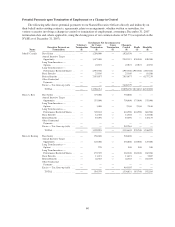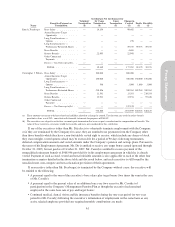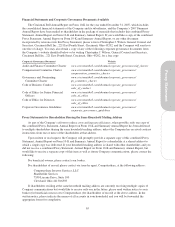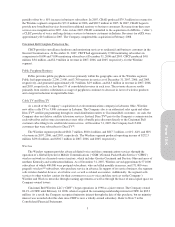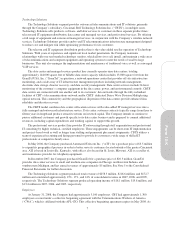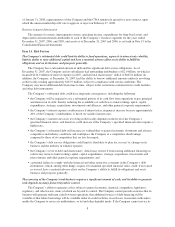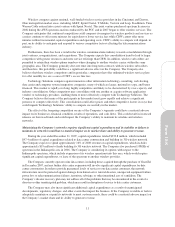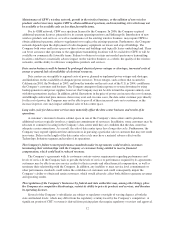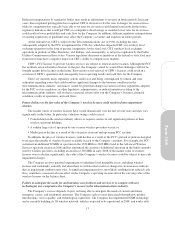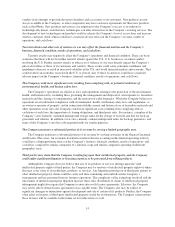Cincinnati Bell 2007 Annual Report Download - page 84
Download and view the complete annual report
Please find page 84 of the 2007 Cincinnati Bell annual report below. You can navigate through the pages in the report by either clicking on the pages listed below, or by using the keyword search tool below to find specific information within the annual report.
Over the past ten years, the Company has expanded its voice and data services beyond its ILEC territory,
particularly in Dayton and Mason, Ohio, through a product suite offered to business and residential customers.
CBET, a subsidiary of CBT, operates as a Competitive Local Exchange Carrier (“CLEC”) and provides
substantially all of its voice and data services on its own network or through purchasing unbundled network
elements (“UNE-L” or “loops”) from various incumbent local carriers. The Wireline segment links the ILEC and
CLEC territories through its Synchronous Optical Fiber Network (“SONET”), which provides route diversity
between the two territories via two separate paths. In March 2007, CBET purchased a local telecommunication
business, which offers voice, data and cable TV services, in Lebanon, Ohio for a purchase price of $7.0 million.
See Note 5 to the Consolidated Financial Statements for further information regarding this acquisition.
The Wireline segment provides voice services over a 100% digital, circuit switch-based network to end
users via access lines. In recent years, the Company’s voice access lines have decreased as its customer base has
increasingly employed wireless technologies in lieu of wireline voice services (“wireless substitution”), or have
migrated to competitors, including cable companies, which offer VoIP solutions. Wireline had approximately
834,000 voice access lines in service on December 31, 2007, which is a 6% and 10% reduction in comparison to
887,000 and 931,000 access lines in service at December 31, 2006 and 2005, respectively.
Despite the decline in access lines, the Wireline segment has been able to nearly offset the effect of these
losses on revenue by:
(1) increasing DSL penetration to existing consumer and business customers; and
(2) increasing the sale of high capacity data circuits to business customers.
The Company has deployed DSL capable electronics throughout its territory, allowing it to offer high-speed
DSL internet access services to over 90% of its in-territory primary consumer access lines. The Company’s DSL
subscribers were 222,000, 198,000, and 162,500 at December 31, 2007, 2006, and 2005, respectively. CBT’s
in-territory primary consumer penetration of DSL service was 42% of addressable lines at the end of 2007, an
increase of 8 percentage points compared to the end of 2006.
Also, CBT’s network includes the use of fiber-optic cable, with SONET rings linking Cincinnati’s
downtown with other area business centers. These SONET rings offer increased reliability and redundancy to
CBT’s major business customers. CBT has an extensive business-oriented data network, offering native speed
Ethernet services over an interlaced ATM – Gig-E backbone network, delivered to end users via high-capacity
circuits. CBT business revenues were $435.1 million, $416.3 million and $412.7 million in 2007, 2006, and
2005, respectively.
In 2007, CBT voice revenue totaled $432.4 million and data revenue totaled $258.6 million, of which $89.2
million was associated with DSL service. Approximately 96% of the voice and data revenue was generated
within the Company’s ILEC operating territory.
CBT’s subsidiary, Cincinnati Bell Telecommunications Services LLC, operates the National Payphone
Clearinghouse (“NPC”) in an agency function, facilitating payments from inter-exchange carriers to payphone
service providers (“PSPs”) relating to the compensation due to PSPs for originating access code calls, subscriber
800 calls, and other toll free and qualifying calls pursuant to the rules of the Federal Communications
Commission (“FCC”) and state regulatory agencies. As the NPC agent, the Company does not take title to any
funds to be paid to the PSPs, nor does the Company accept liability for the payments owed to the PSPs.
Cincinnati Bell Any Distance Inc.
CBAD provides long distance, audio conferencing, and VoIP services to businesses and residential
customers in the Greater Cincinnati and Dayton, Ohio areas. Residential customers can choose from a variety of
long distance plans, which include unlimited long distance for a flat fee, purchase of minutes at a
per-minute-of-use rate or a fixed number of minutes for a flat fee. In addition to long distance, business
customers can choose from a variety of other services, which include audio conferencing, dedicated long
distance, and starting in mid 2006, VoIP. At December 31, 2007, CBAD had approximately 548,000 long
distance subscribers, consisting of 374,000 residential and 174,000 business subscribers, compared to 552,000
and 564,000 long distance subscribers at December 31, 2006 and 2005, respectively. The decrease in subscribers
from 2006 was related to a 5% decline in residential subscribers, consistent with the CBT access line loss,
4


